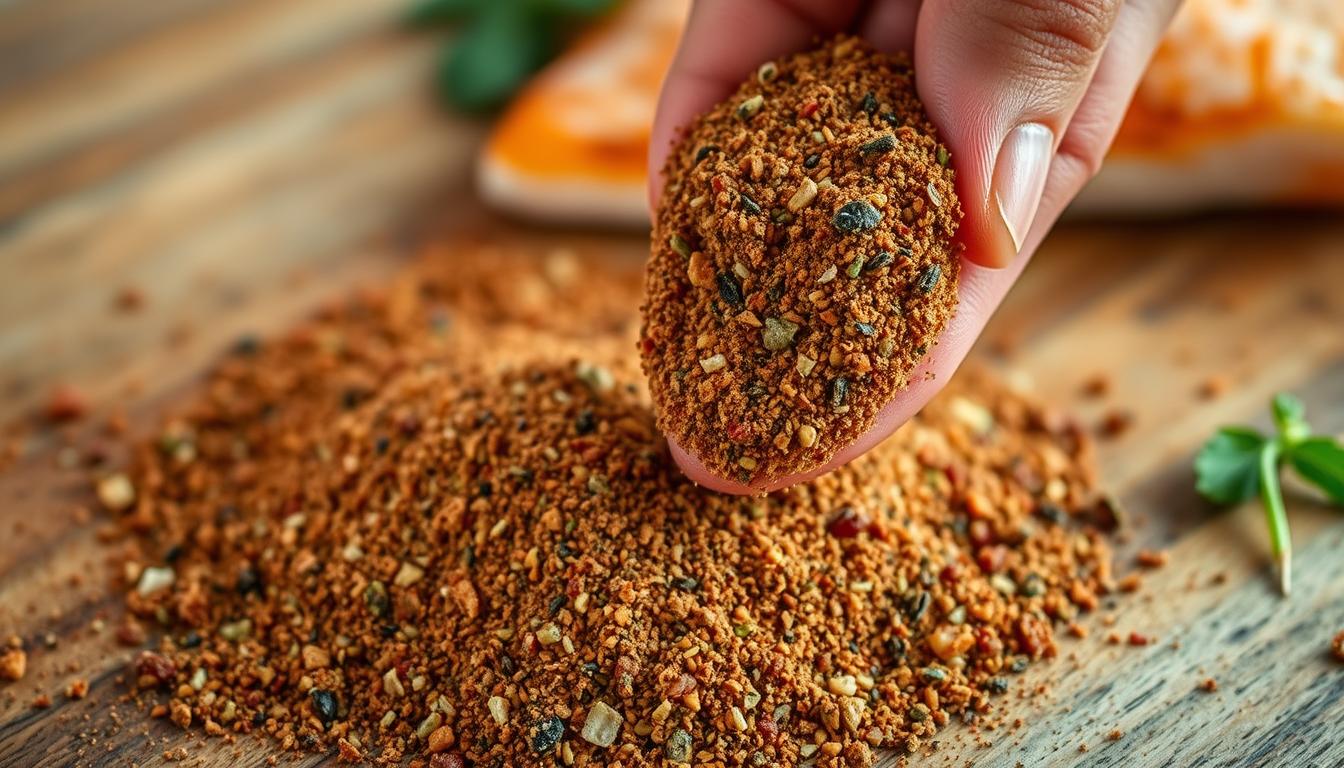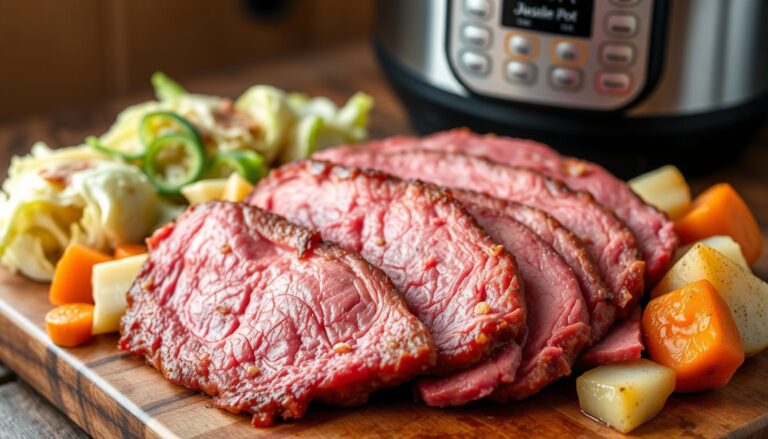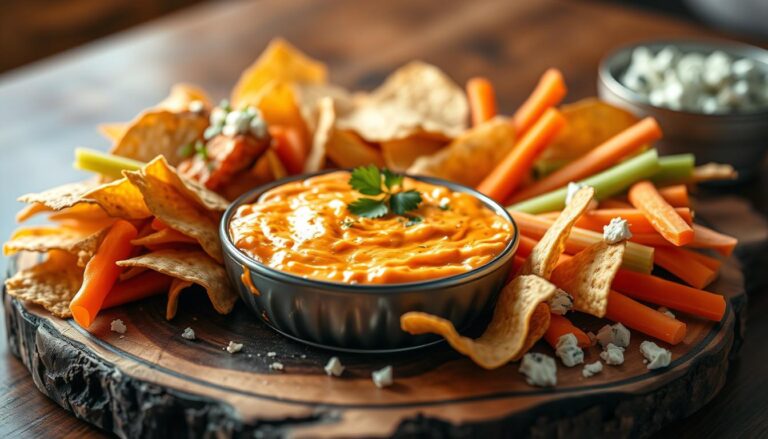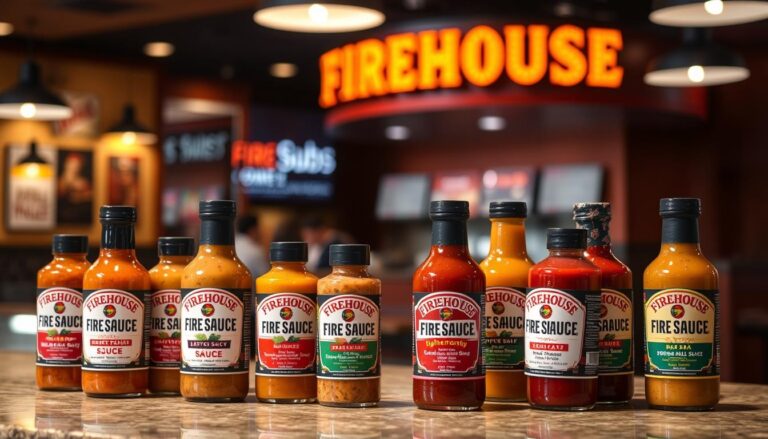The Perfect Blackened Seasoning Recipe
Blackened seasoning is a favorite in many kitchens. It’s loved for its rich, smoky taste. It’s great on seafood and vegetables.
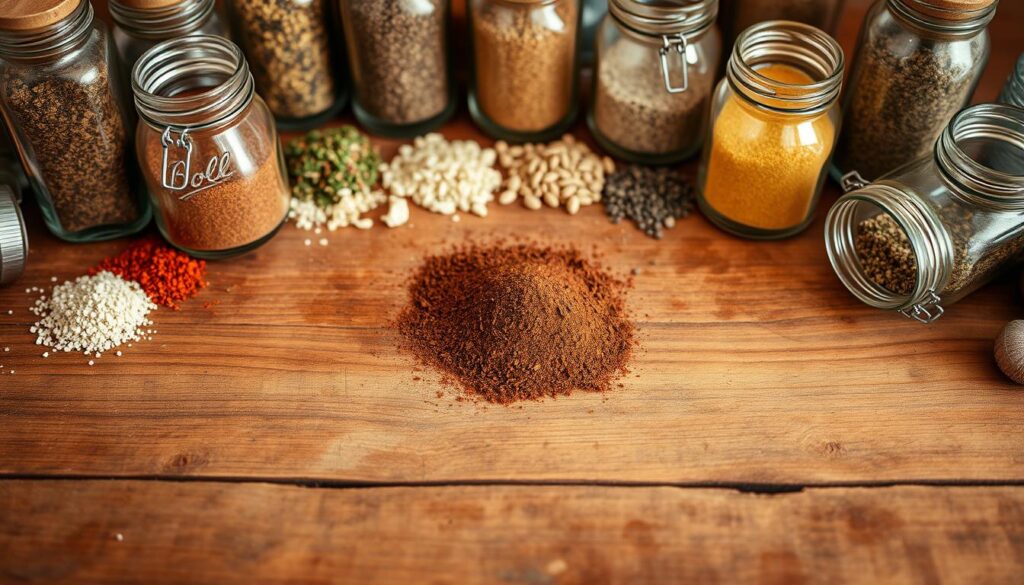
Having a homemade blackened seasoning recipe can make your cooking better. You can change the ingredients to fit your taste and diet.
Key Takeaways
- Learn how to make a delicious blackened seasoning blend at home.
- Discover the benefits of using homemade blackened seasoning in your cooking.
- Explore the versatility of blackened seasoning in various recipes.
- Understand the importance of adjusting ingredients to suit your taste.
- Get tips on storing and using your homemade blackened seasoning.
What is Blackened Seasoning?
Blackened seasoning is a mix of spices that adds a deep, complex flavor to dishes. It’s key to the blackening cooking method. This method is loved for making foods like fish and chicken taste better.
Origins and History of Blackening
The blackening technique started in Louisiana, in Cajun and Creole cooking. Chef Paul Prudhomme made it famous in the 1980s for cooking fish. The food is coated in spices like paprika and thyme, then seared in a hot skillet.
This creates a flavorful crust on the food. The history of blackening shows Louisiana’s mix of cultures. It’s a sign of Cajun cuisine’s creativity with ingredients.
Blackening vs. Other Cooking Techniques
Blackening is different from grilling or sautéing because of its spice crust and high heat. It uses a spice coating to intensify flavors, unlike grilling. Blackening also uses hotter pans and special seasonings for its crust.
Here are some main differences:
- It uses a special seasoning blend.
- It cooks at high heat for the crust.
- It makes a tasty crust on the food.
Knowing these differences helps cooks pick the best method for their dishes.
The Science Behind Blackened Seasoning
The magic of blackened seasoning comes from its mix of spices and the heat it uses. It’s a blend of spices that, when heated, forms a flavorful crust on food.
How Blackening Creates Unique Flavors
The blackening process uses the Maillard reaction to create new flavors. This reaction happens when food is cooked, mixing amino acids and sugars. Spices like paprika, garlic powder, and onion powder in the seasoning enhance this reaction.
This mix of spices and food flavors creates a deep, complex taste. It’s what makes blackened dishes so special.
Heat Reaction and Flavor Development
Heat is key in making blackened seasoning flavors pop. When food with blackened seasoning is cooked hot, the spices form a crust. This crust adds texture and makes flavors more intense.
The blackening spice mix is made to boost these reactions. It ensures the flavors are rich and the texture is great.
Essential Ingredients for the Perfect Blackened Seasoning
To make great blackened seasoning, you need to know its key parts. A good blackened seasoning mix has spices and herbs that work well together. Each one adds its own taste. Knowing these parts is key to making a blackened seasoning recipe that makes dishes better.
Base Spices and Their Flavor Contributions
The base of a blackened seasoning blend is its main spices. These include paprika, garlic powder, onion powder, salt, and black pepper. Paprika gives a smoky taste, while garlic and onion powders add savory notes. Salt boosts the flavor, and black pepper adds a sharp taste. Together, they create a strong flavor that’s typical of blackened dishes.
Heat Elements: Cayenne and Other Peppers
The heat in a blackened seasoning recipe comes from cayenne pepper and other hot peppers. Cayenne pepper is key, giving a spicy kick. Other peppers, like chili powder or red pepper flakes, help adjust the heat to your liking.
Herbs and Aromatics for Depth
Herbs and aromatics add depth and complexity to a blackened chicken spice or any seasoning blend. Thyme, oregano, and sometimes bay leaves are used. They add a subtle, aromatic flavor that goes well with the bold, spicy tastes. Balancing these elements creates a rich, nuanced flavor.
The Ultimate Blackened Seasoning Recipe
The ultimate blackened seasoning recipe combines flavors and techniques to enhance your cooking. It offers a strong, aromatic taste that goes well with many dishes. This includes seafood and vegetables.
Complete Ingredient List and Proportions
To make your own homemade blackened seasoning, you need certain ingredients in specific amounts:
- 2 tablespoons paprika
- 1 tablespoon garlic powder
- 1 tablespoon onion powder
- 1 tablespoon dried thyme
- 1 tablespoon dried oregano
- 1 tablespoon cayenne pepper (adjust to taste)
- 1 tablespoon salt
- 1/2 tablespoon black pepper
- 1/2 tablespoon white pepper
These ingredients are key to your blackened seasoning mix. They offer a mix of smoky, spicy, and savory tastes.
Step-by-Step Mixing Instructions
Making your blackened spice recipe is easy. Just follow these steps:
- In a small bowl, mix together paprika, garlic powder, onion powder, thyme, oregano, cayenne pepper, salt, black pepper, and white pepper.
- Make sure to mix well until everything is well combined.
- Put the blackened seasoning mix in an airtight container.
- Keep the container in a cool, dry place to keep the flavors fresh.
Customization Options for Your Taste
One great thing about making your own homemade blackened seasoning is you can change it to your liking. Here are some ideas:
- For more heat, add more cayenne pepper or other hot peppers.
- For a smokier taste, add more paprika or some smoked paprika.
- For a unique herbal flavor, adjust the thyme and oregano amounts.
By trying out these options, you can make a blackened seasoning ingredients mix that’s just right for you.
Popular Blackened Seasoning Variations
Exploring blackened seasoning shows many variations. Each offers a special twist on the classic recipe. You can find one that adds heat, highlights herbs, or fits dietary needs.
Extra Spicy Blackened Seasoning Blend
Looking for an extra kick? Try an extra spicy blackened seasoning blend. It boosts the heat with more cayenne pepper or hot peppers like habanero or ghost peppers. This makes your dishes bold and fiery.
Herb-Forward Blackened Seasoning Mix
For a different taste, try an herb-forward blackened seasoning mix. It focuses on thyme, oregano, and parsley. This mix adds depth without the intense heat, perfect for those who prefer a balanced flavor.
Salt-Free and Low-Sodium Alternatives
Need to watch your sodium? Salt-free and low-sodium blackened seasoning options are here. They use herbs and spices for flavor, cutting down or removing salt. They’re great for health-focused cooks who want blackened taste without salt.
Perfecting Blackened Fish Seasoning
Getting the perfect blackened fish seasoning is an art. It’s about knowing the seasoning mix and the fish. Blackened fish is loved for its bold taste and how it makes seafood richer.
Best Fish Types for the Blackening Technique
Not every fish is good for blackening. You need fish with firm flesh that can handle high heat. Redfish, Grouper, and Red Snapper are top picks. They get a crispy outside and a soft inside when blackened.
| Fish Type | Flavor Profile | Texture |
|---|---|---|
| Redfish | Mild, Sweet | Firm |
| Grouper | Mild, Slightly Sweet | Firm, Flaky |
| Red Snapper | Delicate, Sweet | Flaky |
Specialized Blackened Seasoning Recipe for Seafood
A special seasoning mix can make seafood dishes better. Use paprika, garlic powder, onion powder, cayenne pepper, and dried thyme. The right mix is key to great flavor.
“The secret to a great blackened fish lies in the seasoning. It’s not just about the heat; it’s about the depth of flavor you bring to the dish.” – Chef Emeril Lagasse
Cooking Techniques for Perfect Blackened Fish
Cooking blackened fish needs a hot skillet, like cast iron, and a bit of oil. Season the fish well with the seasoning mix before cooking. Cook for 3-4 minutes on each side for a crust. This makes a flavorful, spicy dish that wows everyone.
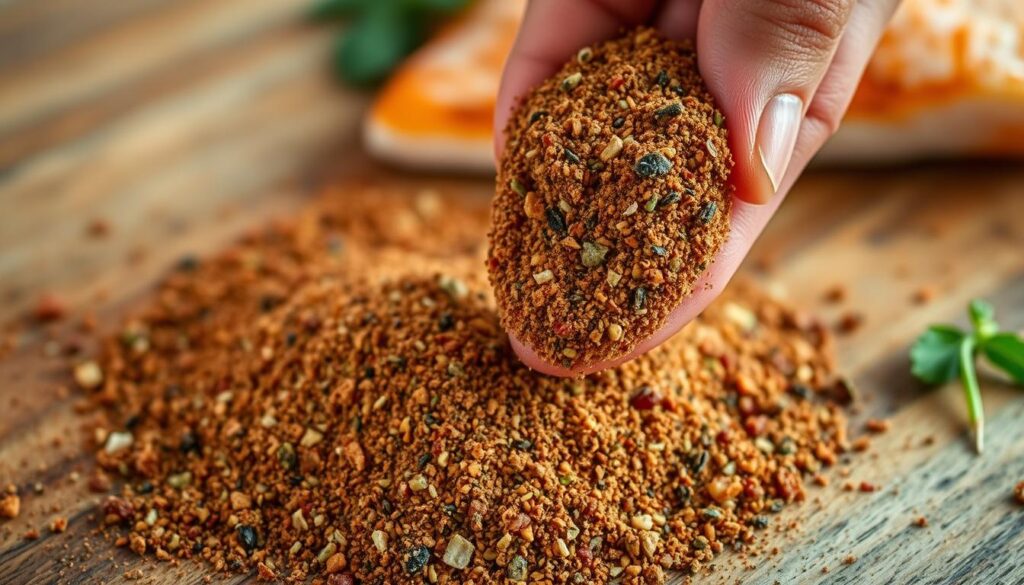
Mastering Blackened Chicken Seasoning
Take your grilled or pan-seared chicken to the next level with blackened chicken seasoning. This spice mix not only boosts flavor but also makes the chicken look great. It adds a crust that makes your meal even better.
Chicken Cut Recommendations for Blackening
The type of chicken you pick matters a lot. Boneless, skinless chicken breasts are popular because they cook well and are easy to season. But, chicken thighs are also great because they stay juicy and tasty, even when cooked hot.
Tailored Blackened Seasoning Recipe for Poultry
For a perfect blackened crust, you need a good blackened chicken seasoning recipe. Mix paprika, garlic powder, onion powder, cayenne pepper, thyme, and oregano. You can adjust the amounts to your liking. Adding a bit of brown sugar helps balance the heat.
Cooking Methods for Juicy Blackened Chicken
To keep blackened chicken juicy, choose the right cooking method. A hot cast-iron skillet is best for a nice sear and moist inside. Grilling or oven-roasting also work well, giving a charred outside and tender inside.
Expanding Your Blackened Seasoning Repertoire
Blackened seasoning is a must-have in every kitchen. It’s not just for fish and chicken. You can use it on many other foods too.
Beef and Pork Applications
Blackened seasoning brings a deep, bold taste to beef and pork. Use it on steaks or roasts for a tasty crust. It’s also great on pork chops or tenderloin, adding a spicy flavor that complements the meat’s sweetness.
- Use on steaks for a bold crust
- Season pork chops for a spicy kick
- Add to roasts for enhanced flavor
Vegetarian and Vegan Blackening Options
Vegetarian and vegan diets can enjoy blackened seasoning’s bold flavors too. It works well on portobello mushrooms, eggplant, and tofu. Just coat your choice with the seasoning before cooking for a delicious meal.
- Portobello mushrooms gain a meaty flavor
- Eggplant becomes tender and flavorful
- Tofu absorbs the spices for a protein-rich option
Unexpected Foods That Shine with Blackened Seasoning
Blackened seasoning isn’t just for meats and veggies. It’s great on popcorn for a spicy snack. You can also season roasted nuts for more flavor. It even adds taste to soups and stews.
- Add to popcorn for a spicy twist
- Season roasted nuts for a flavorful snack
- Enhance soups and stews with a pinch of blackened seasoning
Essential Cooking Techniques for Blackened Foods
Want to make your blackened dishes stand out? Learn the key cooking techniques that make a big difference. Blackened cooking can be done in many ways, each with its own benefits.
Traditional Cast Iron Skillet Method
The classic cast iron skillet method gives you a crispy crust and a juicy inside. Start by heating your skillet over high heat until it’s almost smoking. Add a bit of oil, then your seasoned food.
The high heat seals in the juices and flavors. This method works great for fish and poultry.
Tips for Skillet Blackening: Make sure the skillet is hot before adding food. Also, don’t put too much in the pan to cook evenly.
Oven-Blackening for Larger Batches
Oven-blackening is perfect for big groups or lots of food. First, sear the food in a hot skillet. Then, finish it in the oven.
The oven cooks the food evenly, while the skillet sear gives you that blackened crust.
Benefits of Oven-Blackening: It’s great for big groups and is easier than skillet cooking alone.
Grilling with Blackened Seasoning for Added Smokiness
Grilling with blackened seasoning brings a smoky flavor to your dishes. Preheat your grill to high heat and oil the grates to prevent sticking. Season your food, then grill it.
The smoky taste from the grill mixes well with the spices, making your dish taste amazing.
Grilling Tips: Keep the grill clean and well-oiled to prevent sticking. Also, watch the heat to get the perfect sear.
Blackened Seasoning vs. Cajun Seasoning: Understanding the Difference
Blackened seasoning and Cajun seasoning are often mixed up, but they’re not the same. Both are key in many kitchens, loved for their spicy and rich flavors. Knowing the differences can make your cooking better and help pick the right seasoning for your dishes.
Flavor Profile and Ingredient Differences
Blackened seasoning and Cajun seasoning differ in their ingredients and tastes. Blackened seasoning has spices like paprika, garlic powder, and thyme. It’s made to create a crust on foods, like fish and chicken, when cooked in a hot skillet.
Cajun seasoning comes from Louisiana’s cooking traditions. It has similar spices to blackened seasoning but with stronger flavors. It’s used for blackening and as a general seasoning for many dishes, like soups and stews.
| Characteristics | Blackened Seasoning | Cajun Seasoning |
|---|---|---|
| Primary Use | Creating a crust on proteins | General seasoning for various dishes |
| Key Ingredients | Paprika, garlic powder, onion powder, thyme | Cayenne pepper, oregano, garlic powder, onion powder |
| Flavor Profile | Smoky, slightly spicy, herby | Spicy, robust, earthy |
When to Use Each Type of Seasoning
Deciding between blackened seasoning and Cajun seasoning depends on your dish and desired flavor. Use blackened seasoning for a crispy crust on proteins like fish and chicken. Cajun seasoning is more versatile, great for soups, stews, and roasted veggies.
For blackened redfish, a Louisiana classic, blackened seasoning is best. But for a hearty gumbo, Cajun seasoning adds depth and heat.
Properly Storing Your Homemade Blackened Seasoning
Storing your homemade blackened seasoning right is key to keeping its flavor strong. You worked hard to make it just right. Now, you want it to stay good for a long time.
Container Recommendations for Maximum Freshness
Choosing the right container is vital for keeping your seasoning fresh. Here are some tips:
- Use airtight containers to keep moisture and air out.
- Go for glass or ceramic containers. They don’t react with the seasoning and keep the flavor.
- Opt for containers with tight lids to block air.
Shelf Life and Tips to Preserve Flavor
The shelf life of your seasoning depends on how you store it and the ingredients. If stored well, it can last 6 to 12 months. Here’s how to keep it fresh:
- Store it in a cool, dark spot, away from sunlight and heat.
- Keep it dry to avoid clumps and losing flavor.
- Use a dry spoon or scoop to handle it, to avoid adding moisture.
By following these tips and using the right containers, your homemade blackened seasoning will last longer. It will also keep its taste and strength.
Health Considerations and Benefits of Blackened Seasoning
Blackened seasoning is more than just a flavor enhancer. It also offers nutritional and health benefits. This spice mix boosts the taste of many dishes and adds to their nutritional value.
Nutritional Profile and Antioxidant Properties
Blackened seasoning is packed with antioxidants. Antioxidants help protect the body from free radicals, which can harm cells and lead to chronic diseases. The main ingredients, like paprika, garlic powder, and onion powder, are full of antioxidants.
The nutritional profile of blackened seasoning is mostly good. Most of its ingredients are low in calories but high in vitamins and minerals. For example, paprika is rich in vitamin A, and thyme is a good source of vitamins C and K.
| Ingredient | Nutritional Benefit |
|---|---|
| Paprika | Rich in Vitamin A, antioxidants |
| Garlic Powder | Contains vitamins C and B6, minerals |
| Thyme | Source of vitamins C and K |
Adapting Recipes for Dietary Restrictions
Homemade blackened seasoning is great because it can fit many diets. For those watching their sodium, it’s easy to reduce or skip salt. For those with gluten or dairy restrictions, just make sure the spices used are safe.
By tweaking the recipe or swapping out ingredients, you can make blackened seasoning fit your diet. This makes it a healthy and flexible choice for seasoning many dishes.
Commercial vs. Homemade Blackened Seasoning: Making the Right Choice
Cooks often choose between store-bought and homemade blackened seasoning. This choice depends on convenience, cost, and personal taste.
Popular Store-Bought Blackened Seasoning Brands
Zatarain’s and Tony’s Creole are top names in commercial seasoning. They offer a mix of spices that’s both authentic and easy to use. You can find these in most supermarkets and online.
Old Bay and Cajun Chef also have their own blackened seasoning. They cater to different tastes and regional flavors.
Cost Comparison and Benefits of Homemade Blends
While store-bought seasoning is handy, making your own can save money and let you customize. Homemade seasoning is often cheaper, even when bought in bulk.
| Brand | Price per Ounce | Customization |
|---|---|---|
| Zatarain’s | $0.50 | No |
| Homemade | $0.25 | Yes |
| Tony’s Creole | $0.60 | No |
Homemade blackened seasoning saves money and lets you tailor the flavor to your liking. It’s a great choice for many cooks.
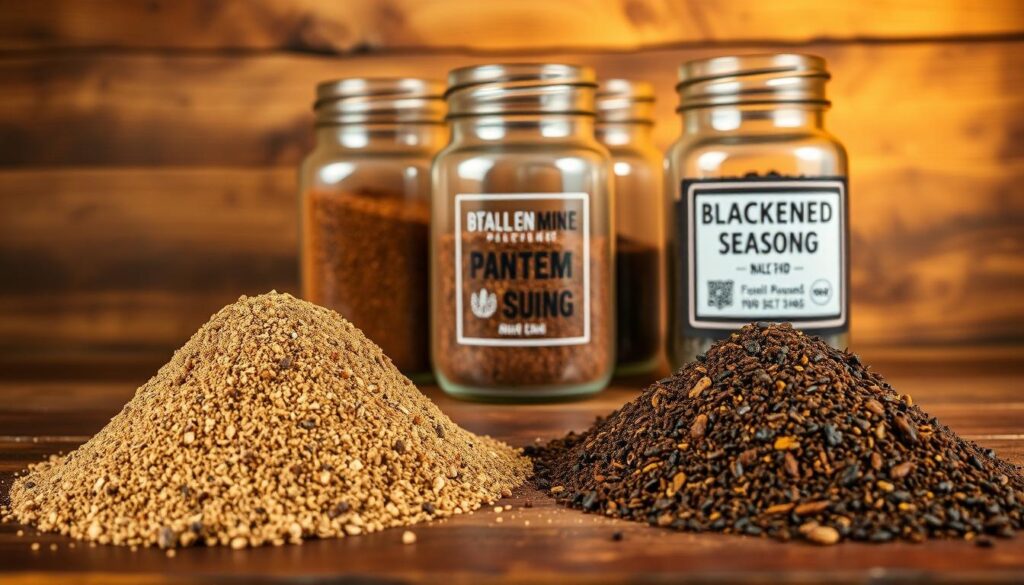
Conclusion: Elevating Your Cooking with Blackened Seasoning
Learning to use blackened seasoning can make your cooking much better. It adds a rich flavor and a bit of expert touch to your meals. By knowing how to use blackened seasoning, you open up a new world of tastes.
Blackened seasoning is more than just a spice. It’s a way to make your dishes truly special. It’s about creating a meal that excites your taste buds.
Having the right blackened seasoning recipe is key. It lets you try it out on different foods like fish, chicken, and veggies. Blackened seasoning brings out the best in what you’re cooking.
It’s not just about following a recipe. It’s about knowing how to mix flavors and techniques. With practice, you can make your cooking truly stand out.
FAQ
What is blackened seasoning?
Blackened seasoning is a mix of spices. It’s used to flavor foods, like meats and seafood. When cooked at high heat, it creates a crust on the surface.
What are the essential ingredients in blackened seasoning?
The key ingredients are paprika, garlic powder, onion powder, and cayenne pepper. Thyme, oregano, salt, and black pepper are also important. Different recipes might have slight variations.
How do I make homemade blackened seasoning?
To make your own, mix together spices like paprika, garlic powder, and onion powder. Add cayenne pepper, thyme, oregano, salt, and black pepper. Stir well in a bowl.
Can I customize blackened seasoning to my taste?
Yes, you can. Adjust the spice amounts or add other ingredients to match your taste. This way, you can make it your own.
What is the difference between blackened seasoning and Cajun seasoning?
Both are used in Southern cooking. But, blackened seasoning is made to create a crust on foods at high heat. Cajun seasoning is a broader mix for adding flavor to many dishes.
How should I store homemade blackened seasoning?
Keep it in an airtight container in a cool, dry place. This helps keep it fresh and flavorful.
Can I use blackened seasoning on vegetables?
Yes, it’s great on veggies. It adds flavor and is perfect for vegetarian and vegan dishes.
Is blackened seasoning healthy?
It’s low in calories and can be healthy in moderation. But, watch the sodium and cooking methods.
Can I make blackened seasoning without salt?
Yes, you can make a salt-free version. Just omit or reduce the salt and adjust the other ingredients.
What are some variations of blackened seasoning?
You can make it spicier with more cayenne pepper. Or, add more herbs like thyme or oregano. There are also salt-free or low-sodium options.

